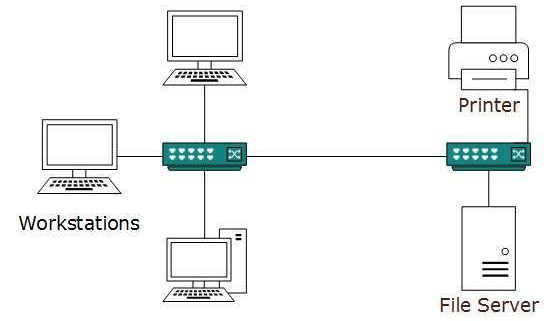
 Data Structure
Data Structure Networking
Networking RDBMS
RDBMS Operating System
Operating System Java
Java MS Excel
MS Excel iOS
iOS HTML
HTML CSS
CSS Android
Android Python
Python C Programming
C Programming C++
C++ C#
C# MongoDB
MongoDB MySQL
MySQL Javascript
Javascript PHP
PHP
- Selected Reading
- UPSC IAS Exams Notes
- Developer's Best Practices
- Questions and Answers
- Effective Resume Writing
- HR Interview Questions
- Computer Glossary
- Who is Who
Local Area Networks
A Local Area Network (LAN) is a private network that connects computers and devices within a limited area like a residence, an office, a building or a campus. On a small scale, LANs are used to connect personal computers to printers. However, LANs can also extend to a few kilometers when used by companies, where a large number of computers share a variety of resources like hardware (e.g. printers, scanners, audiovisual devices etc), software (e.g. application programs) and data.
The distinguishing features of LAN are
- Network size is limited to a small geographical area, presently to a few kilometers.
- Data transfer rate is generally high. They range from 100 Mbps to 1000 Mbps.
- In general, a LAN uses only one type of transmission medium, commonly category 5 coaxial cables.
- A LAN is distinguished from other networks by their topologies. The common topologies are bus, ring, mesh, and star.
- The number of computers connected to a LAN is usually restricted. In other words, LANs are limitedly scalable.
- IEEE 802.3 or Ethernet is the most common LAN. They use a wired medium in conjuncture with a switch or a hub. Originally, coaxial cables were used for communications. But now twisted pair cables and fiber optic cables are also used. Ethernet’s speed has increased from 2.9 Mbps to 400 Gbps.

Wireless LANs (WLAN)
Wireless LANs use high-frequency radio waves instead of cables for communications. They provide clutter free homes, offices and other networked places. They have an Access Point or a wireless router or a base station for transferring packets to and from the wireless computers and the internet. Most WLANs are based on the standard IEEE 802.11 or WiFi.
Virtual LANs (VLAN)
Virtual LANs are a logical group of computers that appear to be on the same LAN irrespective of the configuration of the underlying physical network. Network administrators partition the networks to match the functional requirements of the VLANs so that each VLAN comprise a subset of ports on a single or multiple switches. This allows computers and devices on a VLAN to communicate in the simulated environment as if it is a separate LAN.

